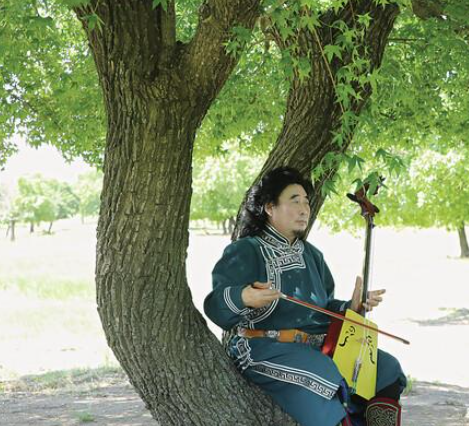The representative inheritor of the intangible cultural heritage project Matouqin - Hada's artistic life
Walking into the Hugeji National Musical Instrument Production and Inheritance Base of Keyou Middle Banner, one wall is covered with honorary certificates and patent certificates, and the other wall is covered with hand-made finished matouqin. There is also "hidden" a stringed instrument maker, Hada, the representative inheritor of the national intangible cultural heritage project national musical instrument production skills (Mongolian stringed instrument production skills).

Hada quietly played the matouqin
The 61-year-old Hada has been interested in storytelling since he was a child under the influence of his grandfather. At the age of 7, he began to learn storytelling and pulling Sihu. At the age of 13, he made the first Sihu in his life. With the background of learning the piano when he was a child, Hada studied the matouqin diligently, and was admitted to Wulan Muqi in Keyouzhong Banner to become a matouqin player, during which he recorded and organized a large number of traditional Mongolian music.
In 1998, Hada started making matouqin. In the same year, Aijima National Musical Instrument Factory was registered and established, and later changed its name to Keyouzhongqi Hugejimu National Musical Instrument Production and Inheritance Base. Since then, Hada has started a long journey of exploration in the production of Mongolian stringed musical instruments.
In 2008, Hada was identified as the representative inheritor of the Mongolian stringed musical instrument production skills in the first batch of intangible cultural heritage projects in the Inner Mongolia Autonomous Region; production skills) representative inheritors.
In order to strengthen training and guidance, so that the intangible cultural heritage with historical, cultural and scientific value can be protected, passed on and developed, Hada cooperated with the Zhongqi Disabled Persons' Federation, various communities, and vocational and technical schools to set up Mongolian stringed musical instrument production skills courses to take the initiative. The gesture of "going out" allows more people to know and understand Mongolian stringed instruments. "More than 500 matouqin players will be trained for free in 2021. The youngest is 15 years old and the oldest is 59 years old, including Han, Mongolian and other multi-ethnic students and farmers and herdsmen." Hada introduced happily.
"This skill cannot be left to our generation, and more people must accept this skill." Hada knew in his heart that the inheritance of matouqin should not be dead-end and must be innovative. Since the traditional matouqin and Sihu materials are greatly affected by environmental factors, humidity and high temperature may cause the matouqin and Sihu to appear at any time during the performance. In order to improve this problem, Hada explored and produced a Mongolian Sihu with variable timbre, clear sound and no noise, and also applied for an invention patent. The Sihu design is different from the current mainstream design. Hada introduced that the muffler he invented was fixed in the Sihu's violin barrel, against the skin, and the tightness of the Sihu's skin was adjusted by twisting the knob, so as to achieve the purpose of adjusting the sound of the Sihu.
For decades, Hada has been doing three things: playing the qin, teaching the qin, and making the qin. So far, Hada has produced more than 10,000 Matouqin, more than 15,000 Sihu, and more than 400 Chaoer. The Matouqin, Sihu, Sanxian and other musical instruments produced by Hada are not only favored by local people from all walks of life, but also exported to Mongolia, Japan, the United States, Australia and other countries, and have been widely praised.
 渝公网安备 50010702504639号
渝公网安备 50010702504639号